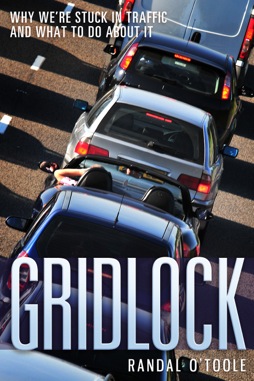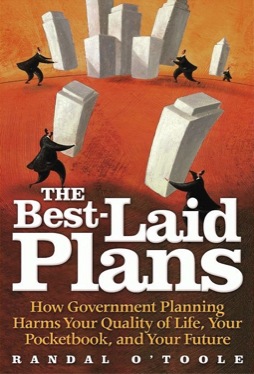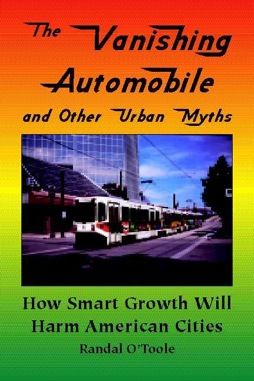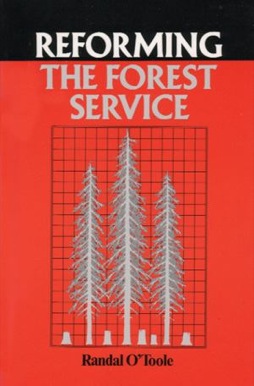America’s transit systems provided 96.3 percent as much service in April 2025 as they did in the same month of 2019, yet carried only 80.6 percent as many riders, according to data released late last week by the Federal Transit Administration. This is slightly less than the percentage of 2019 riders they carried in March.
Transit ridership as a share of pre-pandemic riders dipped slightly in April.
Rather than scale back service to meet reduced ridership demand, transit agencies complain that they are suffering “deficits” that need to be made up for by taxpayers. While I would define “deficits” as “fares minus costs,” transit agencies define them as “fares plus existing tax revenues minus costs.”
In other words, transit officials believe they are simply entitled to all of their existing tax revenues without having to justify them. They want taxpayers to pay even more when ridership declines to make up for revenue shortfalls and pay more when ridership increases to make up for increased operating costs. In fact, there are no circumstances in which transit agencies don’t want taxpayers to pay more.
The CEO of the DC Metro system complains that his system does not enjoy the benefits of “dedicated funding,” as if such funding would end all of its woes. In fact, it does have dedicated funding, namely the fares paid by riders, all of which the transit system gets to keep without paying any of the taxes or fees that a private business would have to pay on such revenues. But the transit way of thinking is that, no matter how much money it gets, it is never enough.
While transit is carrying more than 80 percent of pre-pandemic riders nationally, this number is boosted by ridership in the New York urban area, where transit carries 45 percent of all U.S. transit riders. New York transit carried 85.9 percent of pre-pandemic riders, while transit in the rest of the country carried only 76.5 percent.
Of the top 25 urban areas, just eight others did better than average, including Houston (90%), Las Vegas (91%), Los Angeles (83%), Miami (84%), San Diego (92%), Seattle (80%), Tampa-St. Petersburg (87%), and Washington (88%). Only one in the top 50 exceeded 2019 numbers: Richmond, at 126 percent. Richmond revamped its bus system just before the pandemic, improving service to people going to places other than downtown, and Houston did a similar remake in 2015, contributing to its good performance today.
Transit continues to do poorly in the other 16 of the top 25 urban areas, including Atlanta (59%), Baltimore (76%), Boston (72%), Chicago (70%), Cleveland (76%), Dallas (74%), Denver (61%), Detroit (75%), Minneapolis-St. Paul (58%), Philadelphia (71%), Phoenix (58%), Portland (70%), Riverside (71%), San Antonio (73%), San Francisco (69%), and St. Louis (59%). Atlanta, Phoenix, and Minneapolis-St. Paul are especially pathetic given all of the money they have spent on rail transit.
Transit’s failure to recover to pre-pandemic ridership levels is directly related to the rise of remote working, so employers who order workers back to worksites effectively help the transit industry. Things are not likely to ever return to 2019 numbers, however. More than half of all remote workers say they would quit or at least start looking for another job if ordered back to worksites. Currently about 40 percent either work at home full time or go to a worksite less than five days a week.
This has resulted in permanent shifts that are unfavorable to transit. A recent paper published by the National Bureau of Economic Research found that the average distance people live from their work has risen from 15 miles in 2019 to 26 miles in 2023 and that 12 percent of employees hired since the pandemic began live more than 50 miles from work, compared with 4 percent before.
Even before the pandemic, most urban areas were already losing transit riders. In the five years before 2019, transit lost 35 percent of its riders in Cleveland; 30 percent in Miami; 25 percent in St. Louis and Milwaukee; 20 percent in Los Angeles, Riverside, Sacramento, and San Jose; and 10 to 20 percent in Philadelphia, Atlanta, Boston, San Diego, Tampa-St. Petersburg, Baltimore, Cincinnati, and Kansas City. Of the nation’s 25 largest urban areas, all but four — Denver, Houston, San Antonio, and Seattle — saw ridership decline during those years. The pandemic just accelerated these declines.
As I’ve noted before, transit’s problem is that it is based on a nineteenth-century business model that assumes most jobs are downtown. In fact, outside of New York City, less than 10 percent of urban jobs are in central city downtowns, and transit does a terrible job of serving other urban workers. Before the pandemic, transit carried 29 percent of downtown workers in the nation’s top 50 urban areas but less than 4 percent of workers in the rest of those urban areas.
Transit’s archaic business model stems from its funding sources. Fares covered just 22 percent of transit costs in 2019 and only 11 percent in 2023, so transit agencies are more beholden to politicians than to riders. Politicians and people who influence them, such as newspapers and urban planners, often have their offices downtown and don’t comprehend that downtowns aren’t as important as they once were. Politicians also prefer to fund highly visible projects such as rail construction as opposed to bus operations.
The hundreds of billions of dollars spent in the past few decades on rail transit lines, nearly all of which funnel passengers into a downtown area, underscores transit’s downtown-centric model. This has made transit less resilient in the face of changes such as the growth of edge cities and remote working. Buses are flexible and routes can change overnight. Rails are inflexible and require many years to plan and build, by which time any factors that made them seem to make sense are likely no longer true if they ever were.
The good news is that a few political leaders are no longer impressed by transit’s poor track record and are cutting transit budgets. The bad news is that many if not most seem eager to throw more money at transit no matter how few riders it carries. This is probably an inevitable result of the decision to start subsidizing transit in the first place, which in most of the country goes back to the 1960s.
As usual, you can download my enhanced version of the Federal Transit Administration’s monthly spreadsheet. In both the ridership (UPT) and service (VRM) worksheets, this version has the FTA’s raw data in cells A1 through KD2322, annual totals in columns KE through LB, mode totals in rows 2331 through 2349, transit agency totals in rows 2360 through 3359, and urban area totals in rows 3361 through 3851. Column LC compares April 2025 with April 2019; column LD compares April 2025 with April 2024; and column LE compares 2025 to date with the same months in 2024. I hope you find this useful.









Car dependent low density development doesn’t pay for itself either. Low-density development requires the extension of vast networks of infrastructure (roads, water pipes, sewer pipes, electricity lines, telephone lines, etc.) over much greater distances to serve fewer people compared to compact, higher-density areas. Municipalities and utility providers often bear the upfront costs of this expansion, which are then spread across the entire tax base, regardless of who directly benefits. This means residents in denser areas effectively subsidize the infrastructure costs of those in more sprawling developments. The ongoing maintenance of these extensive networks (road repair, pipe upkeep, etc.) is also more expensive per capita in low-density areas. Again, these costs are often covered by general taxes or utility fees, meaning all residents contribute to the higher operational costs of sprawl. Services like police, fire, school busing, and even mail delivery become less efficient and more costly to provide in sprawling areas due to longer travel distances and lower population densities. These increased operational costs are absorbed by the public budget. New low-density developments often necessitate the expansion of capacity for schools, parks, libraries, water supply, sewage disposal, and arterial roads. The full cost of these capacity increases is rarely borne entirely by the new development, instead being subsidized by existing taxpayers. A significant portion of federal and state funding for highways and roads often comes from general taxes, not just fuel taxes or vehicle registration fees. This “free money” for local decision-makers incentivizes road expansion to serve new, sprawling developments, even if the direct users aren’t covering the full cost. It is estimated that a low density household would have to pay thousands of USD annually in addition to cover the expenses required to fund their low density lifestyle.
Source: https://www.lse.ac.uk/Cities/Assets/Documents/Research-Reports/NCE-Cities-Sprawl-Subsidy-Report.pdf
Systematicvisionary wrote, “Again, these (ongoing maintenance) costs are often covered by general taxes or utility fees, meaning all residents contribute to the higher operational costs of sprawl.”
And those residents are free to move away or not buy in the first place. But it turns out that these operational costs are not high enough to cause much or any flight. In fact, it is what some people call “sprawl” that attracts buyers who call it “nicely spaced housing with a welcome degree of privacy.”
Now, tell us about people living in crowded cities with lousy schools that are paid for by city taxes.
I think you missed my point. Of course the low density people do not flight if they do not have to cover the full costs of their own lifestyle. The American Way of Life is heavily subsidized by the government.
The government is heavily subsidized by the taxpayers.
Which includes those who live in high density development. And taxpayers do not cover the full costs of government. Guess why the national debt is currently 36 trillion USD? A significant amount of US debt (both public + private) is owned by the rest of the world. 30% of the US national debt is owned by foreign countries. Foreign countries hold 11 trillion USD corporate and 1.3 trillion USD in mortgage backed securities. The rest of the world is enabling the American Way of Life, is enabling low density car-dependent sprawl. Furthermore the American Society of Civil Engineers (ASCE) has consistently highlighted a massive investment gap. Their 2025 Infrastructure Report Card estimates that a total of $9.1 trillion is needed for all 18 infrastructure categories to reach a state of good repair. When factoring in projected public and private investments over the next decade, this leaves a funding gap of approximately $3.7 trillion. This figure could rise to $4.4 trillion if funding levels revert to pre-2021 levels. The US does have a significant amount of non-financial debt related to infrastructure, which isn’t even included in the current national debt.
Your knowledge of how infrastructure is implemented and funded in the U.S. is severely deficient because you are blinded by your “vision” as to how you believe they should be implemented funded.
For new development, for example, the developer installs what you believe would be “municipal” infrastructure including traditional structure for gas, water, electric, and wastewater – if applicable.
These utilities are not necessarily provided by a municipality – they are often provided by companies that have certificates of convenience and necessity – giving those companies an exclusive right to provide the services within a particular geographic area.
The people in the subdivision pay for the initial installation because the developer/builder recovers the installation costs by increased housing prices. One flaw with this approach is that the new homeowners have to pay ad valorem taxes on property that isn’t and never will be theirs. But it isn’t the folks in hamster-style housing that are paying for the new infrastructure.
The service provide takes over ownership of the infrastructure and ongoing maintenance. The rates paid by the properties served by these utilities are determined through tariff processes involving state agencies. The rates are generally set to allow the service provider a profit and to recover costs including depreciation over an extended period of time.
I said: “The full cost of these capacity increases is rarely borne entirely by the new development, instead being subsidized by existing taxpayers.”
Developers often install the “last mile” infrastructure (gas, water, electric, wastewater lines within the subdivision) and recover these costs through increased housing prices, meaning the initial homeowners directly pay for that specific on-site infrastructure.
However homeowners and developers do not pay for the “first mile” infrastructure upgrades.
Major Arterial Roads and Highways are funded by state and federal taxes. Expanding these to reach sprawling new developments is a significant cost, and their maintenance is borne by all taxpayers, regardless of where they live. A new subdivision might pay for its internal streets, but not the multi-million dollar highway interchange needed to access it.
Large-Scale Water Treatment Plants, Reservoirs, and Main Transmission Lines, expanding the capacity of these regional systems to serve new, distant, low-density developments is incredibly costly. While connection fees might be paid by the developer, they rarely cover the full cost of increasing overall system capacity and extending major transmission lines over long distances. The existing ratepayers and broader tax base often subsidize these large capital investments. Regional Wastewater Treatment Plants and Large Interceptors, similar to water, expanding these systems to serve new, distant developments incurs significant costs that are not entirely borne by the new residents. Electrical Substations and High-Voltage Transmission Lines, getting power to new, distant subdivisions requires substantial upgrades and extensions to the grid that the local homeowner doesn’t directly pay for upfront beyond their connection fees or through the developer. Even if the utility companies own and maintain their infrastructure, the efficiency of that maintenance is inherently lower in low-density areas. Longer pipe runs, more power lines, and more road surface per customer mean higher operational costs for the utility. While these are passed on through tariffs, the regulatory approval process for these tariffs might allow for cost recovery across a broader customer base, effectively spreading the higher costs of serving low-density areas across all customers, including those in more efficient, denser areas. Beyond private utilities, public services like police, fire, emergency medical services, school busing, snow removal, and garbage collection face vastly higher operational costs in low-density environments. These are primarily funded by property taxes and municipal general funds. When a fire truck has to travel five miles to respond to a call in a low-density subdivision versus one mile in a denser area, the extra fuel, wear-and-tear, and personnel time are subsidized by the general tax base. The counter-argument ignores these significant ongoing public service costs. While true that they pay property taxes on their lot which includes the capitalized cost of some infrastructure, the crucial point is often whether the property tax revenue generated by low-density development is sufficient to cover the full lifecycle costs of the public infrastructure and services it requires. Numerous studies (e.g., by Joe Minicozzi at Urban3) demonstrate that low-density, sprawling developments often have a negative fiscal return for municipalities. The property tax revenue generated per acre or per linear foot of road in a low-density area is often far less than the cost to provide and maintain services to that area. This fiscal deficit is then covered by higher taxes on more productive land uses (e.g., denser commercial or residential areas) or by drawing on state/federal funds. This is a direct cross-subsidy from denser to less dense areas. While developers pay for some initial infrastructure, federal and state governments pour billions into road construction, water projects, and other infrastructure, often disproportionately benefiting new, sprawling development patterns. This funding comes from general taxes (income tax, sales tax, etc.) that all citizens pay, effectively subsidizing the infrastructure that enables low-density growth.
1. The “first mile” is generally already there. The road is not installed based upon maximum capacity today but on anticipated capacity within a horizon timeframe.
2. You still have a mismatch between who is providing the “first mile” and who is providing the last mile AND your density über alles nonsense would require expansion of the “first mile” in your scenarios anyway.
3. To the extent the new properties are within the jurisdiction of a “city”, the city now benefits from the increased taxes it is imposing on the new properties. In addition, many cities impose an “impact fee” to address your complaint. So your complaint carries no water.
4. In Texas, services are often divided among different districts or service providers that have their own boundaries, not “city” boundaries. Your obsession with “city” and failure to be able to define what you mean by “city” is often problematic for your arguments. Within the service provider’s boundaries, it has its own rules/fees etc. for addressing new development regardless of whether it is SFH on lots or tall tower condominiums. There is nothing new here. Service providers other than municipalities have to apply for a “tariff” which determines what the provider can charge. Those fees are designed to recover costs over time and provide for a reasonable profit. Municipalities are the failures here because they aren’t subject to the rate-making rules other providers are. They get caught up in social and political issues and make very, very poor executive decisions. They don’t raise rates when the rates should have been raised. They kill off their reliable sources of power. They run down utility reserves with no plans.
5. Your tired rant is the old “make the new people pay” or “make development pay for itself”. Well the new people/development pay for their own (infrastructure installation capitalized into home prices, impact fees) PLUS they pay higher taxes as a result of the fees capitalized into the housing prices PLUS their taxes are spent on the old. It’s more like the new folks are subsidizing the older development, not vice versa. If you want their tax money you need to provide the same services you provide to other taxpayers.
6. The other problem with your scenarios is that you are stuck on this central control paradigm. Apparently you haven’t considered that there can be multiple water plants each with its own territory, for example.
While major “first mile” infrastructure (e.g., highways, large arterial roads) is often built with future capacity in mind, this doesn’t negate the subsidy. The “horizon timeframe” often anticipates continued low-density sprawl. When that capacity is exceeded, expansion becomes necessary, and it’s almost always funded by regional, state, or federal taxes, not just by the immediate new developments. These expansions are far more expensive in a sprawling landscape than in a compact one. Even if the road is “already there,” the ongoing maintenance of these extensive regional road networks is a perpetual cost. A significant portion of fuel taxes and general tax revenue (federal, state) goes towards maintaining these roads, which are disproportionately utilized by car-dependent, low-density communities. Residents in denser, more transit-oriented areas still contribute to this maintenance burden for infrastructure they may use less frequently or for a shorter portion of their commute. uilding out “excess capacity” often induces further sprawl, reinforcing the cycle of car dependency and the need for more infrastructure expansion down the line, a cycle funded by broad tax bases.
The “mismatch” is precisely where the subsidy lies. The fact that the “first mile” (regional roads, major utility trunks) is funded by a different entity (state/federal government, regional utility authority) than the “last mile” (developer-funded subdivision infrastructure) means the costs are externalized from the direct consumer/developer of the low-density project. The cost of that regional infrastructure is spread across a far wider tax base, including residents in denser areas who might use it less frequently or efficiently. While denser development might require some “first mile” expansion, it does so far more efficiently per capita/unit. A well-planned, dense development can maximize the use of existing “first mile” infrastructure and requires far less new linear expansion for utilities and roads than an equivalent number of residents in a sprawling subdivision. The “density über alles” argument is about optimizing resource use and reducing per capita costs, not about eliminating the need for all infrastructure.
“”To the extent the new properties are within the jurisdiction of a “city”, the city now benefits from the increased taxes it is imposing on the new properties. In addition, many cities impose an “impact fee” to address your complaint. So your complaint carries no water.”
This point misses the crucial distinction between gross revenue and net fiscal impact over time. While impact fees are a step in the right direction, they are rarely set high enough to cover the full lifecycle costs of the infrastructure and services generated by new low-density development. They often cover only a portion of the initial capital costs for specific services (e.g., schools, parks), not the ongoing maintenance, replacement, and operational costs for all municipal services (police, fire, roads, water, sewer, general administration, etc.) over decades. The city might benefit from increased taxes initially, but studies (like those by Strong Towns/Urban3) consistently show that the revenue generated by low-density development often fails to cover the long-term maintenance and service costs. Over 20-30 years, the municipality finds itself with an expanding infrastructure network that generates insufficient revenue to maintain itself, leading to deferred maintenance, crumbling infrastructure, or the need to raise taxes on more fiscally productive areas (like denser commercial districts or apartments) to cover the deficit. This is the cross-subsidy. Focusing only on “increased taxes” without considering the increased costs of providing services to those properties is a fundamental flaw in your “fiscal analysis”.
“”In Texas, services are often divided among different districts or service providers…There is nothing new here…Municipalities are the failures here because they aren’t subject to the rate-making rules other providers are…They kill off their reliable sources of power. They run down utility reserves with no plans.” The existence of multiple districts (MUDs, SUDs, etc. in Texas) doesn’t eliminate the subsidy; it merely shifts who is providing it. These districts often have their own tax base or bond issuance authority. If a new, low-density development within such a district requires costly infrastructure or services that are disproportionately expensive per resident, those costs are still either borne by a broader set of taxpayers/ratepayers within that district or lead to higher taxes/fees for everyone in that district, potentially benefiting the less efficient users. Even with regulated tariffs for private utility providers, the principle of averaging costs across a service area means that customers in efficiently served areas (e.g., existing dense neighborhoods) often pay rates that implicitly subsidize the higher costs of extending and maintaining services to the least efficient, sprawling parts of the service area. The profit margin is built on the average cost, not the individual cost of serving each specific type of development.
“Your tired rant is the old “make the new people pay” or “make development pay for itself”…It’s more like the new folks are subsidizing the older development, not vice versa. If you want their tax money you need to provide the same services you provide to other taxpayers.”
The argument isn’t simply “make new people pay.” It’s about making development patterns pay for their true costs over their lifecycle. It challenges the assumption that all forms of development are equally fiscally beneficial. The claim that “the new folks are subsidizing the older development” is generally contradicted by numerous fiscal impact analyses. Older, often denser, traditional neighborhoods and downtowns typically require less infrastructure per unit, have established infrastructure that is largely paid off (or nearing payoff), and generate significant property tax revenue relative to their service costs. The new, sprawling developments are often the ones that require massive new capital outlays and disproportionately higher ongoing operational costs, creating a long-term fiscal deficit that the older, more productive parts of the city often have to cover. Yes, new homeowners pay higher taxes due to capitalized infrastructure costs and impact fees. But the point is whether those higher taxes are enough to cover the actual higher costs of serving that specific development pattern. The evidence suggests they often are not, particularly over the long term.
“The other problem with your scenarios is that you are stuck on this central control paradigm. Apparently you haven’t considered that there can be multiple water plants each with its own territory, for example.”
While multiple plants and districts exist, the concept of a larger regional system or interconnected utility network often exists for efficiency and resilience. Sprawling development still necessitates extending the network (whether from one plant or multiple) over greater distances to serve fewer people. Regardless of how many plants or districts exist, the fundamental principle remains: the cost of providing water, sewer, or any utility service to a customer decreases as density increases (up to a point of extreme density where new challenges emerge). A system serving a wide, dispersed customer base will inherently have higher per-customer costs for infrastructure and maintenance than one serving a compact, concentrated customer base. These higher costs, regardless of the provider’s structure (private or municipal), are ultimately borne by the ratepayers, often averaged across the system, thus creating an implicit subsidy for the less efficient, low-density connections.
Nope. Systematicvisionary says: “which are disproportionately utilized by car-dependent, low-density communities”
Nope. They aren’t being used by “car-dependent low-density communities” until those communities exist. Depending upon the infrastructure you are referring to, once those “car-dependent low-density communities” exist they pay through taxes, impact fees, or through increased tariffs. Let’s also not forget the impact fees and increased tariffs are often paid up front, not in arrears even though the upgrades aren’t in place.
Your argument ignores lifecycle costs, operational costs and externalities. See my post below!
Systematicvisionary says: “When a fire truck has to travel five miles to respond to a call in a low-density subdivision versus one mile in a denser area, the extra fuel, wear-and-tear, and personnel time are subsidized by the general tax base.”
As mentioned before we use emergency service districts (“ESD”) to provide these services in much of the state. The taxes to support the district are sales and ad valorem taxes. The ad valorem taxes are borne by most properties in the district, except other government properties. More density would probably necessitate the need for more trucks. Your density argument really falls flat here.
Your formula also fails for another reason. ESDs assist each other all the time. If there is a fire emergency in particular, you may have fire trucks from multiple ESDs show up. I don’t think you’ll hear the taxpayers in one area whining about the other as long as there is reciprocation of assistance.
Your other arguments regarding “public infrastructure” is not really about density v sprawl but bad management by cities. The rate-making bodies are pretty good at ensuring non-governmental utilities have an assured reasonable return on investment and there are allowances for depreciation and other costs. It is the cities that have no such rate analysis or which do not allow those services to operate as a utility that get into trouble.
People tend to prefer less dense environments than the hamster-style housing arcology you promote. Get over it.
By the way, calling yourself “visionary” is a bit narcissistic and the objectives you promote are not new nor “visionary”.
The existence of ESDs, funded by sales and ad valorem taxes, doesn’t negate my argument; it often reinforces it. Even within an ESD, providing services to a sprawling, low-density area means longer travel times, more fuel consumption, more wear and tear on vehicles, and greater personnel time per incident/resident. If a fire truck has to drive 10 miles to reach a house in a low-density area versus 2 miles to reach a house in a denser area (even if both are in the same ESD), the operational cost per household served is demonstrably higher in the low-density scenario. This higher operational cost is then spread across all taxpayers in the ESD through sales and ad valorem taxes. This means the dense developments (which require less travel for the same service) are effectively subsidizing the less efficient service delivery to the sprawling areas.
“More density would probably necessitate the need for more trucks. Your density argument really falls flat here.”
Wrong, more density concentrates demand, allowing for more efficient deployment.
In a sprawling area, you might need numerous geographically dispersed fire stations, each with a truck, because response times are critical, and distances are great. Each station might have a large “empty” service area. In a denser area, you might need more trucks overall for a larger population, but they can be strategically placed closer to the demand, leading to faster response times and more efficient use of each truck (i.e., each truck serves more people and more calls within a smaller, more accessible radius). The argument isn’t about avoiding the need for any trucks or services, but about achieving greater efficiency and lower cost-per-person for these services in denser environments. A dense area can support a higher call volume with fewer stations than an equally populated but sprawling area.
“Your formula also fails for another reason. ESDs assist each other all the time. If there is a fire emergency in particular, you may have fire trucks from multiple ESDs show up. I don’t think you’ll hear the taxpayers in one area whining about the other as long as there is reciprocation of assistance.”
Mutual aid agreements are essential for emergency services and a sign of good regional cooperation, but they don’t negate fiscal inefficiencies or subsidies. Mutual aid is a crucial safety net, particularly for large-scale incidents. However, relying on frequent mutual aid to cover the day-to-day inefficiencies of a poorly planned, sprawling service area means that the more fiscally responsible districts are effectively bailing out the less efficient ones. While “reciprocation of assistance” is the ideal, if one ESD consistently has higher call volumes (due to sprawl, for example) and disproportionately relies on mutual aid from a more fiscally efficient or denser district, the “whining” might not be public, but the fiscal strain is still present on the contributing district. The denser district’s taxpayers are essentially paying for their own efficient services and helping to cover the higher costs of a neighboring sprawling area.
“Your other arguments regarding “public infrastructure” is not really about density v sprawl but bad management by cities. The rate-making bodies are pretty good at ensuring non-governmental utilities have an assured reasonable return on investment and there are allowances for depreciation and other costs. It is the cities that have no such rate analysis or which do not allow those services to operate as a utility that get into trouble.”
egardless of management quality, it will always be more expensive per capita to build and maintain linear infrastructure (roads, pipes, wires) and to deliver services (police, fire, trash) over long distances to a dispersed population compared to a concentrated one. This is a matter of physics and geometry, not management. Even a perfectly managed utility or city will face higher absolute costs in a sprawling environment per resident served.
The opponent confirms the existence of utility regulation designed to ensure “reasonable return on investment” and “allowances for depreciation.” This is precisely where the averaging of costs leads to subsidies. If a utility extends a water line 10 miles to serve 50 homes, the cost per home for that extension is astronomically high. To make it “reasonable” for those 50 homes, the utility averages that cost across its entire customer base, including thousands of homes in denser areas where the infrastructure cost per home is much lower. This is an implicit cross-subsidy from the efficient customers to the less efficient ones, built into the very structure of utility rate-making to achieve a “reasonable return.” The “bad management” argument deflects from this fundamental pricing mechanism.
If cities do fail to raise rates or adequately account for costs, as the opponent suggests, then this explicitly means they are subsidizing the service for those receiving it, which often disproportionately benefits low-density areas where costs are highest. So, even if it’s “bad management,” it results in a subsidy for low-density development.
“People tend to prefer less dense environments than the hamster-style housing arcology you promote. Get over it.”
This is an emotionally charged point, but it’s a non-sequitur to the financial argument and employs a loaded term.
People’s preferences are valid, but they do not negate the fiscal realities or the externalities of those preferences when translated into development patterns. The argument is not about dictating where people should live (even if this doesn’t invalidate to argue for such measure), but about exposing who pays the full price for those choices. If people prefer low-density, they should ideally pay the actual cost of that preference, rather than having it subsidized by others.
“Hamster style housing” is a dismissive term misrepresents the range of denser housing options available, from traditional main street housing to townhomes, small-lot single-family homes, and mid-rise apartments, all of which are significantly more fiscally efficient than sprawling subdivisions. The argument is for a wider range of housing choices that are fiscally sustainable, not for forcing everyone into “arcologies.” In many markets, the current regulatory environment (zoning, minimum lot sizes) and infrastructure funding mechanisms limit the availability of diverse housing types, making low-density sprawl the only financially viable option for many developers and the only available option for many homebuyers, even if they might prefer something different if fully priced.
“They aren’t being used by ‘car-dependent low-density communities’ until those communities exist.”
This point misses the causal relationship. While the communities don’t physically use the infrastructure until they exist, the decision to build major “first-mile” infrastructure (highways, expanded arterial roads, large utility trunks) is often made in anticipation of, and to enable, future low-density development. Without these regional investments, such development might not be feasible or desirable. This means the investment is made, and its cost is borne by the general public, before the specific low-density community even comes online to “pay” for it. When a major highway interchange is built or expanded specifically to serve a new exurban development, the cost is socialized across all taxpayers (federal, state fuel taxes, general funds) – not just the future residents of that development. This infrastructure enables sprawl, and its construction and maintenance costs are front-loaded onto the broader public.
“Once those ‘car-dependent low-density communities’ exist they pay through taxes, impact fees, or through increased tariffs.”
As previously argued, the crucial point is not just that new properties generate some tax revenue. It’s whether they generate enough revenue to cover the costs of services they require over their entire lifespan. Numerous fiscal impact studies demonstrate that low-density development often has a negative net fiscal impact. The revenue per acre or per linear foot of infrastructure is often lower than the cost to provide and maintain services (roads, water, sewer, police, fire, schools) to those dispersed homes. When the property tax revenue from a low-density subdivision falls short of its true cost, the municipality must make up the difference from its general fund. This general fund is fed by all taxpayers, including those in more fiscally efficient, denser areas (like apartment buildings or commercial centers). Thus, residents in denser areas effectively subsidize the operational costs of the less efficient, low-density areas. This isn’t theoretical; it’s a demonstrable fiscal reality in many cities.
“Depending upon the infrastructure you are referring to, once those “car-dependent low-density communities” exist they pay through taxes, impact fees, or through increased tariffs. Let’s also not forget the impact fees and increased tariffs are often paid up front, not in arrears even though the upgrades aren’t in place.”
Impact fees are generally designed to cover only a portion of the initial capital costs of infrastructure necessitated by new development (e.g., a new school, a fire station, or a specific road improvement). They are almost never set high enough to cover the full lifecycle costs of all infrastructure (initial construction, ongoing maintenance, eventual replacement) or the higher operational costs of public services (e.g., longer police routes, more school busing).
Impact fees often target specific services and don’t account for the broader ripple effects of sprawl, such as increased regional traffic congestion or environmental degradation, whose costs are borne by the wider public.
Paying an impact fee “up front” for a partial cost does not mean the development has paid its full share of costs over the long term. It’s like paying a small down payment on a house but then relying on others to cover half your mortgage and utility bills for the next 30 years.
hile tariffs are designed to recover costs and ensure profit, utility companies typically average costs across their entire service territory. This means that a customer in a densely populated area, whose service requires minimal infrastructure extension and maintenance, pays roughly the same rate as a customer in a far-flung, low-density area whose service requires significantly more expensive infrastructure (longer pipes, more pumping stations, more frequent line checks over vast distances). This averaging effectively creates a cross-subsidy where customers in denser areas are subsidizing the higher infrastructure and operational costs of serving customers in less dense areas. The person in the apartment building is paying a portion of the cost of extending that water line 5 extra miles to the rural subdivision. While connection fees might exist, the long-term maintenance and eventual replacement of these extended utility networks are covered by ongoing tariff revenues, which means the higher costs of serving sprawl continue to be averaged across the entire customer base for decades.